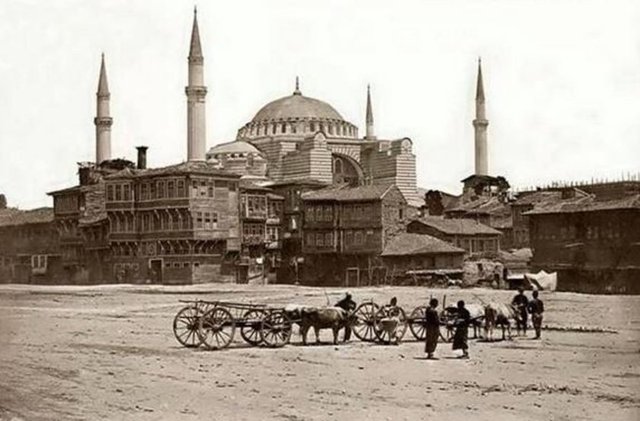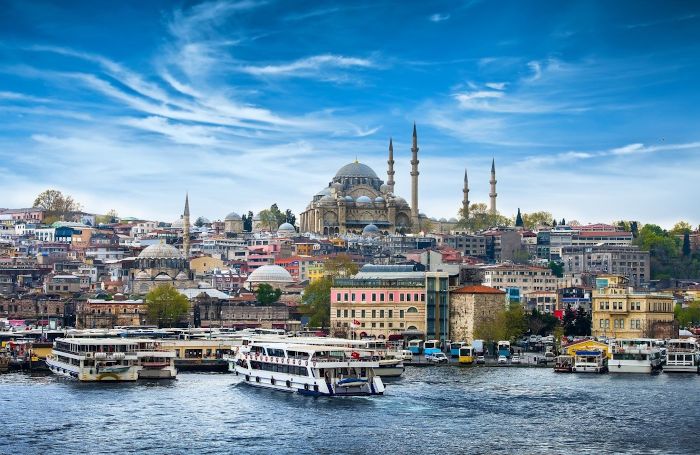Ancient Turkey
Catal Huyuk was one of the world's first towns. It was built in what is now Turkey about 6,500 BC not long after farming began. Catal Huyuk probably had a population of about 6,000. In Catal Huyuk the houses were made of mud brick. Houses were built touching against each other. They did not have doors and houses were entered through hatches in roofs. Presumably having entrances in the roofs was safer then having them in the walls. (Catal Huyuk was unusual among early towns as it was not surrounded by walls). Since houses were built touching each other the roofs must have acted as streets! People must have walked across them. In Catal Huyuk the dead were buried inside houses. (Although they may have been exposed outside to be eaten by vultures first).
Although Catal Huyuk was a true town (defined as a community not self-sufficient in food) as least some of its people lived by farming. They grew wheat and barley and they raised flocks of sheep and herds of goats. They also kept dogs. As well as farming the inhabitants of Catal Huyuk also hunted animals like aurochs (wild cattle), wolves, foxes and leopards.Catal Huyuk was abandoned about 5,000 BC.

The Hittites
The Hittites were the first civilization in Turkey. They moved to Turkey about 2,000 BC and at first they were divided into separate states. However about 1,650 BC they were united by King Labarnas. The Hittites were a powerful and warlike people. About 1595 BC they captured Babylon. Later the Hittites fought against Egypt. The Hittites reached a peak under King Suppiluliumas (c. 1380 - c. 1346 BC). Under him the Hittites ruled not just most of Turkey but also parts of Syria and Palestine.
The Hittite capital was at Hattushash. In it there were many temples. Like other ancient peoples the Hittites were polytheists (they worshiped many gods). Chief among them were the weather god Tarhun and his wife Istanu. There were many other gods and goddesses each of whom ruled some natural phenomena. However the mighty Hittite state broke down about 1,200 BC when people from the Aegean attacked it called the 'Sea Peoples' and in time the Hittites were largely forgotten.

However by his time there was a new power in the Middle East - the Persians. The Persian Empire was created by Cyrus II, known as Cyrus the Great (559-529 BC). Cyrus first defeated another Iranian people called the Medes, then in 547 Cyrus defeated the kingdom of Lydia (in what is now Turkey) at the battle of Pterya and he became the ruler of most of Asia Minor. Soon afterwards Cyrus also defeated the Greek cities on the coast of Turkey. (These had been founded by the Greeks as colonies many years before).
However in 334 BC Alexander the Great crossed the Dardanelles and swiftly conquered the Persian Empire including Turkey. Alexander died in 323 BC and his empire was divided between his generals. Turkey became split into rival kingdoms. Meanwhile in 279 BC Celts invaded Western Turkey and carved out a kingdom there. They became known as the Galatians.By the 2nd Century BC Rome was the dominant power in the region and in 133 BC the ruler of a kingdom named Pergamon left his kingdom to Rome. That was the beginning of Roman rule. Over the next 100 years the Romans gradually extended their rule over Turkey.In the First Century As the missionary Paul travelled to Turkey and Christianity took root in many cities. The new religion grew rapidly despite persecution. However persecution ended in 313 when the Emperor Constantine became a Christian. In 330 Constantine moved his capital to Byzantium, which was renamed Constantinople. (It is now called Istanbul).
In the 4th Century the Roman Empire split in two. The Western half declined and in the 5th Century it was conquered by Germanic peoples. However the Eastern half of the Roman Empire flourished. Today we call it the Byzantine Empire and it included what is now Turkey.
The Ottoman Turks
About 1288 a man named Osman created a new state in Turkey, which became the nucleus of a great Empire - the Ottoman Empire. In the 14th century the Ottomans gradually extended their territory and in 1453 they captured Constantinople bringing the Byzantine Empire to an end.
After they captured Constantinople (which was renamed Istanbul) the Turks made inroads into Europe. They captured the Balkans. They also captured Egypt in 1517 and in the 16th century the Ottoman Empire was immensely powerful and rich. However the Ottoman Empire reached a peak under Suleiman I (1520-66) known as Suleiman the magnificent. In 1522 he captured Rhodes and in 1526 he captured Hungary but he failed to capture Malta in 1566. The Turks were defeated at sea by the Spanish and Venetians at the battle of Lepanto in 1571. Nevertheless the Turks were left a force to be reckoned with. In 1573 they captured Cyprus.
In the 17th century the Turkish Empire declined (although it remained very powerful). As late as 1683 the Turks lay siege to Vienna but they were driven back. Afterwards the Turks were forced to surrender territory to the Europeans. (The Turks surrendered Hungary by a treaty of 1699). In the 18th century there were several wars between Russia and the Turkish Empire and the Russians gradually took land from them.

In the 19th century the Turkish Empire was faced with the rise of nationalism in Europe. The first country to break away was Greece in 1832. In the 19th century the Turkish Empire continued to decline. Abdulhamid II (1876-1909) attempted to modernize Turkey by building railways and telegraph lines but his rule was repressive.
Meanwhile parts of the Turkish Empire broke away. In 1878 Romania and Serbia became independent. Bulgaria became independent in 1908. Also in 1908 a revolution took place in Turkey and the Sultan was forced to call elections. The next year he abdicated and his replacement was only a figurehead.
Modern Turkey
Then in 1914 Turkey joined the German side in the First World War. However Turkey surrendered on 30 October 1918. Afterwards the Turks were stripped of their empire. Greece, France, Italy and Britain occupied parts of Turkey. The Sultan was powerless so in 1920 General Mustafa Kemal formed a national assembly in Ankara. Kemal and his army drove out foreigners in the Turkish War of Independence 1920-22 and in November 1922 the national assembly abolished the sultanate. Mustafa Kemal became president of Turkey. Kemal introduced reforms and made Turkey a modern, secular state. He also promoted education and introduced a modified Latin alphabet. The fez was abolished in 1925 and in 1934 women gained full voting rights. Mustafa Kemal took the name Kemal Ataturk. He remained president of Turkey until his death in 1938.
In 1999 Turkey was formally accepted as a candidate for EU membership. In the early 21st century the economy of Turkey is growing rapidly. Important industries in Turkey are tourism and textiles.


© 2022 All Rights Reserved For Ren Restorasyon İnşaat Sanayi A.Ş